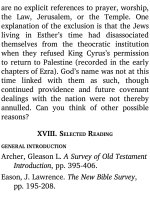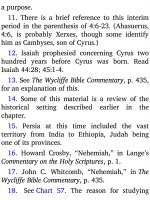Jensens survey of the old testament adam 519
Bạn đang xem bản rút gọn của tài liệu. Xem và tải ngay bản đầy đủ của tài liệu tại đây (116.97 KB, 4 trang )
3. Are there many personal references?
4. Did you sense any particular tone or
atmosphere in the letter?
5. Does Paul seem to have one speci c
purpose in writing?
6. What are your personal impressions of
the book?
B. PARAGRAPH SURVEY
1. Read the letter again, a little more
slowly. Begin to underline words and
phrases that strike you as you read.
2. Make a list of the key words and
phrases, and add to the list while you
continue your studies.
3. Mark paragraph divisions in your Bible,
with each paragraph beginning at these
verses: 1:1, 2, 6; 2:1, 7, 13, 17; 3:1, 6, 11;
4:1, 9, 13; 5:1,6, 12, 23,25, 28.
4. Read the paragraphs, and assign a
paragraph title to each.
5. What are your new impressions of the
epistle? What parts stand out prominently?
C. OBSERVING THE STRUCTURE
Now begin to see how the nineteen
paragraphs
(thought
units)
of
1
Thessalonians
merge
together
to
communicate Paul’s message. Things to look
for are suggested below.
1 . Introduction and conclusion. Read the
rst and last paragraphs of the epistle. What
verses would you identify as the
introduction and the conclusion?
2. Blocks of similar content. Go through the
epistle again, and see if you can nd any
groups of paragraphs that are of similar
content, of such kinds as doctrine,
exhortation, personal re ections, and
biography. Make a note of those.
3 . Turning point. Sometimes a book has a
turning point, such as a change from
doctrine to practice. Do you detect any such
change in 1 Thessalonians?
4. High points and climax. Occasionally, an
epistle will reach a high point, or high
points, in the course of the writing. A
doxology at such a place is often a clue to
this. Do you observe any peaks in 1
Thessalonians? Would you say that there is a
de nite climax toward the end of the
epistle? If so, where specifically?
5 . A prominent doctrine. Observe the
references to Christ’s return at the end of
each chapter. What paragraphs in the epistle
deal especially with this event of end times?
D. SURVEY CHART
Chart 90 is a survey chart of 1
Thessalonians, showing the basic structure
of the epistle and outlines of various topics.
Study this chart very carefully.
Observe the following on the chart:
1. The salutation of 1:1 and the assorted
verses of 5:23-28 are viewed here as the
introduction and conclusion, respectively.
2. A major division appears at 4:1,
dividing the epistle into two main parts.
What two outlines show this twofold
division? (Note: the rst word of 4:1 is
“ nally,” which suggests a change in Paul’s
train of thought at this point.) Review the
survey study made thus far to check
whether these twofold outlines represent the
epistle’s general content.
3. You have already observed that Paul









